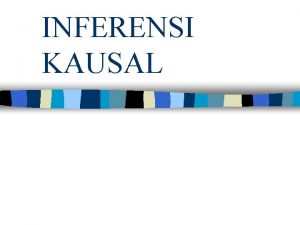Inference for High Dimensional Causal Models using Dynamic

- Slides: 1

Inference for High Dimensional Causal Models using Dynamic Discretized Belief Propagation Peng Lin Risk and Information Management Group School of Electronic Engineering and Computer Science p. lin@eecs. qmul. ac. uk 1. Background Multivariate Gaussian (MG) Model Test Numerically evaluate the compound sums of F 1. 1 (Loss Severity Xi and Loss Occurrence N are random variables) is one of the pillars of classical risk theory and non-life insurance, increasingly in recent years the aggregated models have been used in operational risk and credit risk modeling. The density function of SN is N-fold convolution with Xi (F 1. 2). We aim to evaluate the above model innovatively using Bayesian Network (BN) to produce context aware computational intelligence for operational risk measurement. BN is a probabilistic model consisting of a set of nodes and directed edges to perform Bayesian probabilistic reasoning and Inference in decision making. Figure 2. Five dimensional Multivariate Gaussian models are binary factorized in BN representation 2. Challenges Problems 2. Figure 3. large clusters are approximated by smaller regions using Belief Propagation 4. MG Experimental Results Mean Variance 99 th 99. 9 th Exact DDBP Figure 1. Sum of Generally correlated R. V. s using BNs. Problem: 1. Produce large Node Probability Table size when child node has more than three parents. 2. Produce large cluster size when using Junction Tree as inference algorithm, which makes it computational inefficient. 3. Our Approach 1. Binary factorization 2. Dynamic Discretized Belief Propagation (DDBP) X 0 2. 0 1. 99 4. 07 6. 62 6. 67 8. 19 8. 90 X 1 3. 0 2. 99 9. 0 9. 14 10. 07 9. 98 X 2 4. 0 16. 16 13. 34 13. 14 16. 34 18. 19 X 3 5. 0 4. 98 25. 0 25. 76 16. 25 16. 71 20. 39 20. 85 X 4 6. 0 5. 99 36. 0 36. 46 19. 85 20. 30 24. 49 26. 06 12. 18 12. 48 5. Advantages 1. Unified approach to approximate high dimensional models BN representation. 2. Computational efficient, change exponential calculations to linear. 3. Open large applications using BN modelling, i. e. finance.

